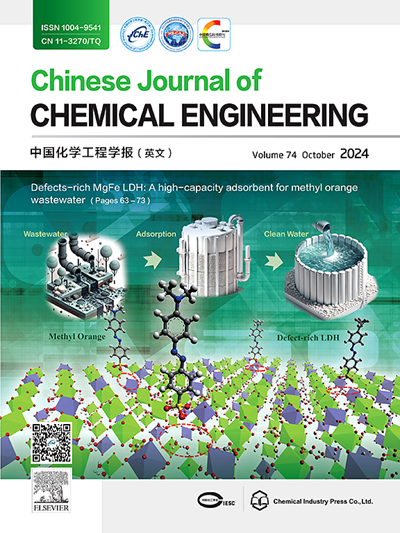压力驱动过滤法对水合物相脱盐效率的研究
IF 3.7
3区 工程技术
Q2 ENGINEERING, CHEMICAL
引用次数: 0
摘要
水合物脱盐的机理是,在天然气水合物形成过程中,水分子会转移到水合物相,而盐离子会相反地集中在未反应的盐水中。但水合物分解水的含盐量和水合物相的淡化程度尚不清楚。最大的挑战是如何有效地分离水合物相和剩余未反应的盐水,然后分解水合物相来测量水合物熔融水的盐浓度。本工作开发了一种装置和压力驱动过滤方法,以有效地分离水合物相和剩余未反应的盐水。在此基础上,得到单水相,解离水合物,测定水合物熔体水的盐浓度。实验结果表明,当初始盐质量浓度为0.3% ~ 8.0%时,形成CO2水合物对NaCl溶液的脱盐效率为15.9% ~ 29.8%,对CaCl2溶液的脱盐效率为28.9% ~ 45.5%。溶质CaCl2比溶质NaCl更容易被去除。另外,形成CO2水合物的脱盐效率高于形成甲烷水合物的脱盐效率。多级脱盐可以不断降低水合物解离水的盐浓度,每级脱盐效率在20%左右。本文章由计算机程序翻译,如有差异,请以英文原文为准。
Study on the desalination efficiency of hydrate phase by a pressure-driven filtration method
The mechanism of hydrate-based desalination is that water molecules would transfer to the hydrate phase during gas hydrate formation process, while the salt ions would be conversely concentrated in the unreacted saltwater. However, the salt concentration of hydrate decomposed water and the desalination degree of hydrate phase are still unclear. The biggest challenge is how to effectively separate the hydrate phase and the remaining unreacted salt water, and then decompose the hydrate phase to measure the salt concentration of hydrate melt water. This work developed an apparatus and pressure-driven filtration method to efficiently separate the hydrate phase and the remaining unreacted saltwater. On this basis, the single hydrate phase was obtained, then it was dissociated and the salt concentration of hydrate melt water was measured. The experimental results demonstrate that when the initial salt mass concentration is 0.3% to 8.0%, the salt removal efficiency for NaCl solution is 15.9% to 29.8% by forming CO2 hydrate, while for CaCl2 solution is 28.9% to 45.5%. The solute CaCl2 is easier to be removed than solute NaCl. In addition, the salt removal efficiency for forming CO2 hydrate is higher than that for forming methane hydrate. The multi-stage desalination can continuously decrease the salt concentration of hydrate dissociated water, and the salt removal efficiency per stage is around 20%.
求助全文
通过发布文献求助,成功后即可免费获取论文全文。
去求助
来源期刊

Chinese Journal of Chemical Engineering
工程技术-工程:化工
CiteScore
6.60
自引率
5.30%
发文量
4309
审稿时长
31 days
期刊介绍:
The Chinese Journal of Chemical Engineering (Monthly, started in 1982) is the official journal of the Chemical Industry and Engineering Society of China and published by the Chemical Industry Press Co. Ltd. The aim of the journal is to develop the international exchange of scientific and technical information in the field of chemical engineering. It publishes original research papers that cover the major advancements and achievements in chemical engineering in China as well as some articles from overseas contributors.
The topics of journal include chemical engineering, chemical technology, biochemical engineering, energy and environmental engineering and other relevant fields. Papers are published on the basis of their relevance to theoretical research, practical application or potential uses in the industry as Research Papers, Communications, Reviews and Perspectives. Prominent domestic and overseas chemical experts and scholars have been invited to form an International Advisory Board and the Editorial Committee. It enjoys recognition among Chinese academia and industry as a reliable source of information of what is going on in chemical engineering research, both domestic and abroad.
 求助内容:
求助内容: 应助结果提醒方式:
应助结果提醒方式:


